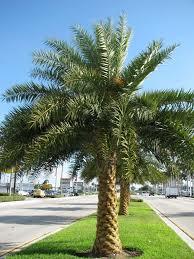|
|
|
Phoenix Palm
|
|
|

|
|
|
|
This genus is mostly medium to robust in size but also includes a few dwarf species; trunks are solitary in four species, suckering and clumped in nine, of which one has a prostrate ground trunk. Many of the trunked species do not form above-ground stems for several years. The pinnate leaves, 1–6 m long, all share the common feature of metamorphosed lower-leaf segments into long, vicious spines (acanthophylls). The leaves have short or absent petioles and possess the rare feature among pinnate palms of induplicate (V-shaped) leaflets. The plants are dioecious, with male and female flowers on separate plants; pollination is by both wind and insect. The flowers are inconspicuous yellowish-brown and about 1 cm wide, but grouped on conspicuous large multi-branched panicles 30–90 cm long. The inflorescence emerges from a usually boat-shaped, leathery bract, forming large, pendent clusters. Phoenix fruit develops from one carpel as a drupe, 1–7 cm long, yellow to red-brown or dark purple when mature, with one elongate, deeply-grooved seed.
|
|
|
|
|
|
|
|
|
|